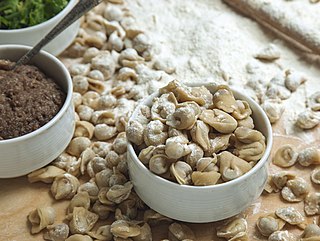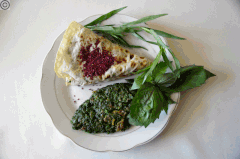
In North America, a corn tortilla or just tortilla is a type of thin, unleavened flatbread, made from hominy, that is the whole kernels of maize treated with alkali to improve their nutrition in a process called nixtamalization. A simple dough made of ground, dried hominy, salt and water is then formed into flat discs and cooked on a very hot surface, generally an iron griddle called a comal.

Lavash is a thin flatbread usually leavened, traditionally baked in a tandoor or on a sajj, and common to the cuisines of South Caucasus, West Asia, and the areas surrounding the Caspian Sea. Lavash is one of the most widespread types of bread in Armenia, Azerbaijan, Iran and Turkey. The traditional recipe can be adapted to the modern kitchen by using a griddle or wok instead of the tonir.

Russian cuisine is a collection of the different dishes and cooking traditions of the Russian people as well as a list of culinary products popular in Russia, with most names being known since pre-Soviet times, coming from all kinds of social circles.

Champurrado is a chocolate-based atole, a warm and thick Mexican beverage. It is prepared with either a masa , masa harina, or corn flour ; piloncillo; water or milk; and occasionally containing cinnamon, anise seed, or vanilla. Ground nuts, orange zest, and egg can also be added to thicken and enrich the drink. Atole drinks are whipped up using a wooden whisk called a molinillo. The whisk is rolled between the palms of the hands, then moved back and forth in the mixture, until it is aerated and frothy; a blender may also be used.

Gözleme is a savory Turkish stuffed turnover. The dough is usually unleavened, and made only with flour, salt and water, but gözleme can be made from yeast dough as well. It is similar to bazlama, but is lightly brushed with butter or oil, whereas bazlama is prepared without fat. The dough is rolled thin, then filled with various toppings, sealed, and cooked over a griddle. Gözleme may sometimes be made from prepackaged hand-rolled leaves of yufka dough.

Belarusian cuisine refers to the culinary traditions native to Belarus. It shares many similarities with cuisines of other Eastern, Central and Northeastern European countries, based predominantly on meat and various vegetables typical for the region.

Indian breads are a wide variety of flatbreads and crêpes which are an integral part of Indian cuisine. Their variation reflects the diversity of Indian culture and food habits.

Uzbek cuisine shares the culinary traditions of peoples across Central Asia. There is a great deal of grain farming in Uzbekistan, so breads and noodles are of importance, and Uzbek cuisine has been characterized as "noodle-rich". Mutton is a popular variety of meat due to the abundance of sheep in the country and it is a part of various Uzbek dishes.
Potato cake is a name given to various shaped potato dishes around the world, including a patty of hashed potatoes, a fried patty of mashed potato, a fried and battered slice of potato, or a flatbread made with mashed potato and flour. In Northern England and some states in Australia, a thin slice of potato that is battered and deep fried may be called a potato scallop. In Australia and New Zealand, the terms potato cake, potato flip and potato fritter may be used.

Palestinian cuisine consists of foods from or commonly eaten by Palestinians, whether in Palestine, Israel, Jordan, or refugee camps in nearby countries, or by the Palestinian diaspora. The cuisine is a diffusion of the cultures of civilizations that settled in the region of Palestine, particularly during and after the Islamic era beginning with the Arab Ummayad conquest, then the eventual Persian-influenced Abbasids and ending with the strong influences of Turkish cuisine, resulting from the coming of the Ottoman Turks. It is similar to other Levantine cuisines, including Lebanese, Syrian and Jordanian.
Pastel is the Spanish and Portuguese word for pastry, a sugary food, and is the name given to different typical dishes of various countries where those languages are spoken. In Mexico, pastel typically means cake, as with Pastel de tres leches. However, in different Latin American countries pastel can refer to very different sugary dishes, and even to non-sugary ones as well. In some places, like Brazil, a pastel can refer to both a sugary and non-sugary food, depending on the filling used.
Azerbaijani cuisine is the cooking styles and dishes of the Republic of Azerbaijan. The cuisine is influenced by the country's diversity of agriculture, from abundant grasslands which historically allowed for a culture of pastoralism to develop, as well as to the unique geographical location of the country, which is situated on the crossroads of Europe and Asia with access to the Caspian Sea. The location has enabled the people to develop a varied diet rich in produce, milk products, and meat, including beef, mutton, fish and game. The location, which was contested by many historical kingdoms, khanates, and empires, also meant that Azerbaijani cuisine was influenced by the culinary traditions of multiple different cultures, including Turkic, Iranian, and Eastern European.

Cheburek are deep-fried turnovers with a filling of ground or minced meat and onions. A popular street dish, they are made with a single round piece of dough folded over the filling in a crescent shape. They have become widespread in the former Soviet-alligned countries of Eastern Europe in the XXth century.

Shekarbura is a sweet pastry.

Dumpling is a broad class of dishes that consist of pieces of cooked dough, often wrapped around a filling. The dough can be based on bread, wheat or other flours, or potatoes, and it may be filled with meat, fish, tofu, cheese, vegetables, or a combination. Dumplings may be prepared using a variety of cooking methods and are found in many world cuisines.

Joshpara is a kind of dumpling popular in Central Asia, South Caucasus and the Middle East. They are made of unleavened wheat dough squares filled with ground meat and condiments. In observance of the Islamic dietary rules, the meat filling is usually without pork.

Sheki halva, or pakhlava, is a type of dessert specific to the Sheki region of Azerbaijan.

Shorgoghal is a traditional Azerbaijani pastry in a round shape filled with anise or fennel seed, cumin, cinnamon, turmeric, salt and pepper. It is mainly prepared for Novruz in Azerbaijan along with pakhlava and shekerbura.

















